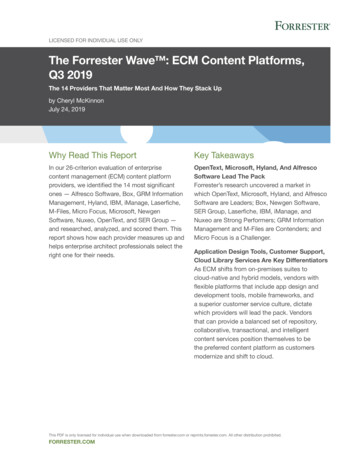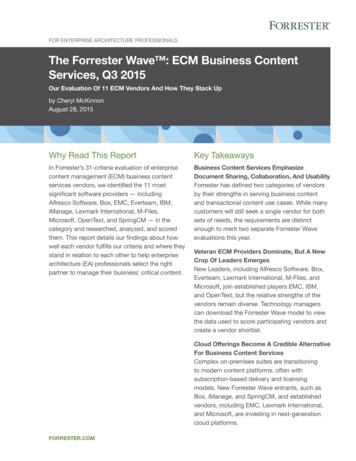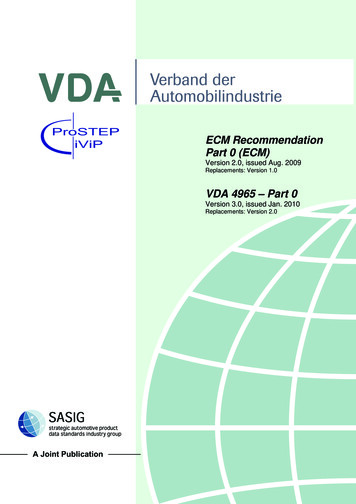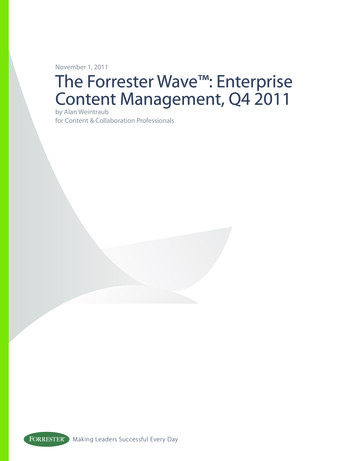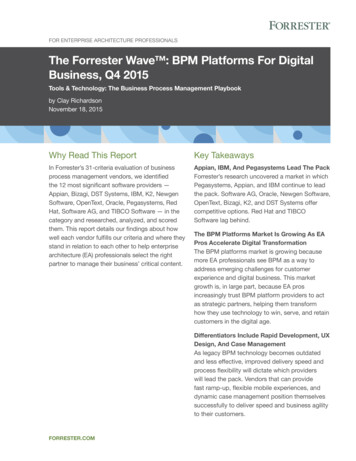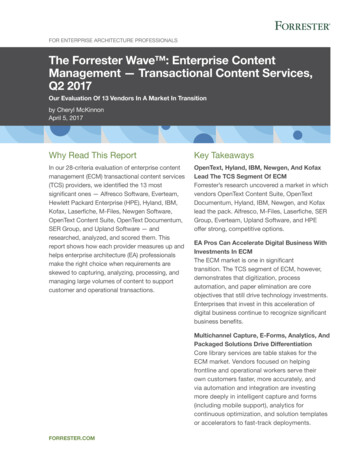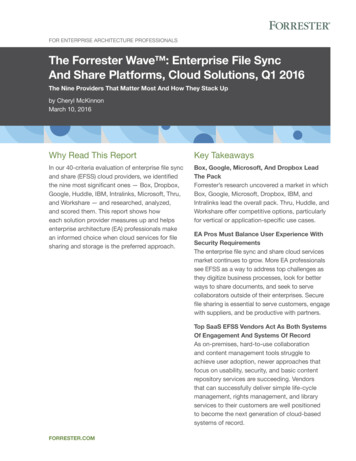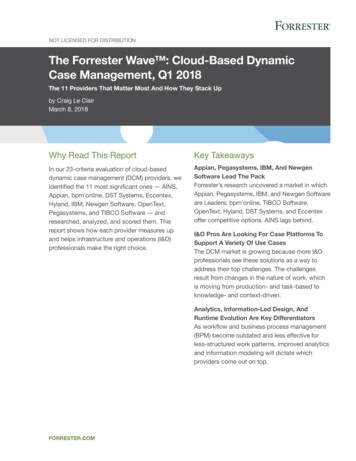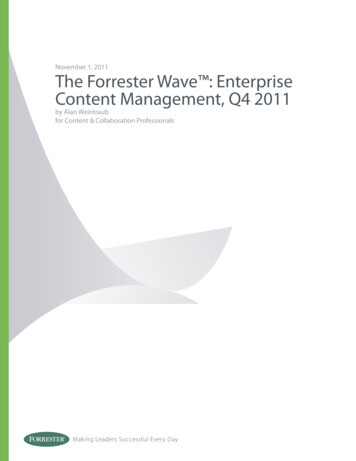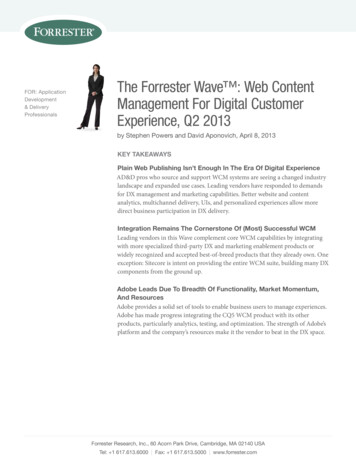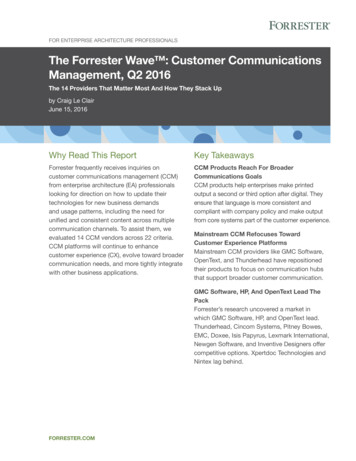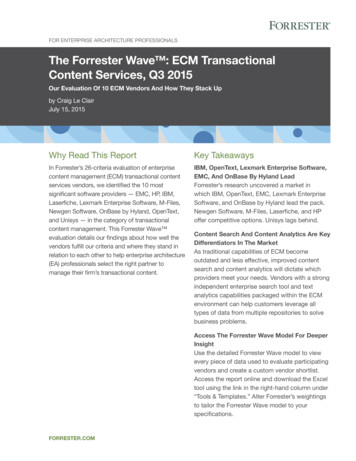
Transcription
For Enterprise Architecture ProfessionalsThe Forrester Wave : ECM TransactionalContent Services, Q3 2015Our Evaluation Of 10 ECM Vendors And How They Stack Upby Craig Le ClairJuly 15, 2015Why Read This ReportKey TakeawaysIn Forrester’s 26-criteria evaluation of enterprisecontent management (ECM) transactional contentservices vendors, we identified the 10 mostsignificant software providers — EMC, HP, IBM,Laserfiche, Lexmark Enterprise Software, M-Files,Newgen Software, OnBase by Hyland, OpenText,and Unisys — in the category of transactionalcontent management. This Forrester Wave evaluation details our findings about how well thevendors fulfill our criteria and where they stand inrelation to each other to help enterprise architecture(EA) professionals select the right partner tomanage their firm’s transactional content.IBM, OpenText, Lexmark Enterprise Software,EMC, And OnBase By Hyland LeadForrester’s research uncovered a market inwhich IBM, OpenText, EMC, Lexmark EnterpriseSoftware, and OnBase by Hyland lead the pack.Newgen Software, M-Files, Laserfiche, and HPoffer competitive options. Unisys lags behind.Content Search And Content Analytics Are KeyDifferentiators In The MarketAs traditional capabilities of ECM becomeoutdated and less effective, improved contentsearch and content analytics will dictate whichproviders meet your needs. Vendors with a strongindependent enterprise search tool and textanalytics capabilities packaged within the ECMenvironment can help customers leverage alltypes of data from multiple repositories to solvebusiness problems.Access The Forrester Wave Model For DeeperInsightUse the detailed Forrester Wave model to viewevery piece of data used to evaluate participatingvendors and create a custom vendor shortlist.Access the report online and download the Exceltool using the link in the right-hand column under“Tools & Templates.” Alter Forrester’s weightingsto tailor the Forrester Wave model to yourspecifications.forrester.com
For Enterprise Architecture ProfessionalsThe Forrester Wave : ECM Transactional Content Services, Q32015Our Evaluation Of 10 ECM Vendors And How They Stack Upby Craig Le Clairwith Leslie Owens, Cheryl McKinnon, Elizabeth Cullen, and Diane LynchJuly 15, 2015Table Of Contents2 Providers Address Old Headaches AndExciting New OpportunitiesThe ECM Market Addresses Age-OldChallengesECM Providers Also Address EmergingOpportunitiesFocused ECM Players Expand Their CoreCompetence5 A Transactional ECM Evaluation OverviewThe Transactional ECM Research AssessmentSelected Vendors Meet The TransactionalECM Requirements Of DemandingEnterprisesNotes & ResourcesForrester conducted demonstrations andexecutive strategy briefings with 10 vendors inMarch 2015: EMC, HP, IBM, Laserfiche, LexmarkEnterprise Software, M-Files, Newgen Software,OnBase by Hyland, OpenText, and Unisys.Related Research DocumentsCultivate The Right Mix Of Skills To Execute OnAn ECM Program: Map Roles To Key ProcessesECM Requires Investment: The Five Key ElementsTo Include In Your Business CaseTechRadar : Digitizing Operational Processes,Q2 20158 Broad Integration And PartnershipsDifferentiate The Market Leaders10 Vendor ProfilesLeaders Make The Most Of Installed BaseAnd Product BreadthStrong Performers Are A Mix Of EmergingAnd Established ProvidersContenders Round Out The Field13 Supplemental MaterialForrester Research, Inc., 60 Acorn Park Drive, Cambridge, MA 02140 USA 1 617-613-6000 Fax: 1 617-613-5000 forrester.com 2015 Forrester Research, Inc. Opinions reflect judgment at the time and are subject to change. Forrester ,Technographics , Forrester Wave, RoleView, TechRadar, and Total Economic Impact are trademarks of ForresterResearch, Inc. All other trademarks are the property of their respective companies. Unauthorized copying ordistributing is a violation of copyright law. Citations@forrester.com or 1 866-367-7378
For Enterprise Architecture ProfessionalsJuly 15, 2015The Forrester Wave : ECM Transactional Content Services, Q3 2015Our Evaluation Of 10 ECM Vendors And How They Stack UpProviders Address Old Headaches And Exciting New OpportunitiesForrester defines the enterprise content management market according to how the content is put touse. Business content helps workers complete tasks and share ideas. It may originate internally or bereceived from partners, prospects, or clients. Business content includes familiar formats, such as officedocuments, presentations, spreadsheets, and rich media. Transactional content generally originatesoutside of the enterprise from third parties, such as customers and partners, and relies on complexworkflows or business process management (BPM) to drive processes. Many companies are miningcustomer interactions to find patterns and trends in what clients say to predict how they might behavein the future.The ECM Market Addresses Age-Old ChallengesTransactional content services, as a market, has evolved steadily since the early 1990s, with strongestmarket growth when the paper channel dominated. EA pros are still fighting the headwinds of pooruser adoption, customized one-off solutions, heavyweight and difficult-to-maintain systems, and overbudget projects. But the current crop of providers moves forward with:›› Deep experience in key transactional applications. Account opening, invoice processing, loanorigination, and employee or customer onboarding are typical transactional content use cases.These take in external content from customers, extract needed information, and integrate well withcore systems. Our vendor surveys revealed that the providers we’ve evaluated have thousands ofcustomers in each of these areas. Experience matters.›› Improved search and content sharing. ECM decision-makers name finding and sharing contentas a top requirement. In previous ECM assessments, solutions depended more on complex,hierarchical folder interfaces that did not serve the needs of information workers. Today, ourevaluation shows advancement in enterprise search and federated capabilities and better use ofricher metadata for access.›› A stronger emphasis on consolidation and repository integration. Our reviews highlightedcontent integration. Why? Given the distinct business needs that ECM can serve, many enterpriseshave installed ECM solutions tactically — resulting in a collection of dissimilar platforms. In fact,migration now appears as one of the top challenges faced by ECM program leaders.1 Mostproviders we reviewed showed specific migration tools and have formed professional servicegroups to help.›› Lighter on-premises solutions with enhanced architectures. Enterprise content management’slong history has resulted in heavy architectures that are slow to change. That’s why we askedcustomers to rate the overall product architecture: how recently it was refreshed, the extent ofRESTful application programming interfaces (APIs), web clients, lightweight payload formats (e.g.,JavaScript object notation [JSON]), in-memory databases, and lightweight process communication. 2015 Forrester Research, Inc. Unauthorized copying or distributing is a violation of copyright law.Citations@forrester.com or 1 866-367-73782
For Enterprise Architecture ProfessionalsJuly 15, 2015The Forrester Wave : ECM Transactional Content Services, Q3 2015Our Evaluation Of 10 ECM Vendors And How They Stack UpCloud vendors have architectures that are more modern and agile and will increasingly give onpremises suites competition. The more traditional vendors reviewed have started recognizingpossible disruption and are beginning to catch up.›› Improved implementation time and integration. Simpler design, development, and deploymentof applications — now decoupled from repositories — allow designers, subject matter experts, andbusiness analysts to take a greater role in implementation. The products in this evaluation showedimproved implementation features, and customers reported faster time-to-value. We also sawenhanced interoperability standards, such as the content management interoperability services(CMIS) standard.ECM Providers Also Address Emerging OpportunitiesThe transactional ECM segment manages content for core business processes that tend to bestructured, with predictable, high-volume tasks that use transactional content and have a strong needto integrate with other systems and processes. These core processes present a great opportunity forECM to provide more direct customer and revenue value. Advancement in analytics, integration withemerging cloud solutions, enterprise search and federated access, open APIs, and mobile contentsupport now offer new life to the market. In particular, we saw providers:›› Ramping analytics to drive insight and reduce administrative burden. Analytics are changingthe way content and data are used, and while all the ECM products we reviewed offer reportingcapabilities and some level of administrative dashboards, only a few have bundled interactiveanalytics into core offerings. Insights from big data initiatives, combined with historical text-basedcontent, will ultimately pay off. Yet today, analytics is most used for retention and disposal policies,automated capture, or classification. Over time, big data initiatives and traditional content andrecords management practices are on a collision course.›› Accelerating their move to cloud. The providers we reviewed are launching a range of managedservices and software-as-a-service (SaaS) offerings. New competitive threats loom from bothenterprise-grade file sync and share tools and SaaS archiving platforms. As a result, all thereviewed companies, including EMC, HP, OnBase by Hyland, IBM, OpenText, and LexmarkEnterprise Software, have made substantial investments in data centers and cloud infrastructure.Vendors will need to overcome the lingering privacy, security, and compliance fears thatorganizations still have about using cloud services to manage and store their enterprise contentand business records.›› Moving quickly to fill gaps in their mobile road maps. Client-facing professionals are authoringand editing documents jointly with their customers, often with tablets. People create documents,spreadsheets, and presentations — the nuts and bolts of enterprise content — on mobile devices.It’s no surprise that since our 2013 ECM Forrester Wave, vendors have launched, acquired, orretooled their mobile interfaces and apps.2 We surveyed the participating vendors’ customersand asked them to rate the overall mobile readiness of the provider’s ECM product based on the 2015 Forrester Research, Inc. Unauthorized copying or distributing is a violation of copyright law.Citations@forrester.com or 1 866-367-73783
For Enterprise Architecture ProfessionalsJuly 15, 2015The Forrester Wave : ECM Transactional Content Services, Q3 2015Our Evaluation Of 10 ECM Vendors And How They Stack Upinterface for smartphones and tablets; the ECM capabilities exposed via mobile; mobile interactionwith workflow; and mobile capture. For the majority of these vendors, Forrester would like to see amore unified approach to mobile across ECM access points.›› Using stronger and more open APIs that spur innovation. ECM vendors have wrapped theirown APIs in web services to advance interoperability. APIs specific to a single vendor repositorylimit the ability of partners, systems integrators (SIs), and customers to develop contentapplications and cultivate developer expertise. Lack of programmer skills inhibits continuousimprovement of content applications. Customized suites become more difficult to upgrade, andarchitects find it harder to keep pace with new content creation tools adopted by their businessusers. Overall, we found an improvement in APIs and integration capability. Integrations withtransactional systems (e.g., Oracle and SAP) have matured, deployment of CMIS 1.0 has advancedfor most, and representational state transfer (REST) APIs are supported by all. Some providershave introduced point-and-click configuration tools for consuming external devices and data toavoid writing “look ups.”›› Improving process support for potentially embedding smart process apps. This developmentwould usher in a fresh approach to solving specific problems that heavy-footprint systems ofrecord — such as ECM or enterprise resource management suites — struggle to fill. Businessactivities that are people-intensive, highly variable, structured loosely, and subject to changecan be addressed by new types of application-building platforms. Providers in this research withcombined strengths in capture, ECM, case management, and e-signature are early leaders in thisemerging technology market.Focused ECM Players Expand Their Core CompetenceIn this Forrester Wave, we evaluated transactional ECM providers that cover broad use cases,industries, and geographies and are primarily enterprise software companies. Box, Everteam, andSpringCM focus on business content requirements but may be a good fit for transactional use casesinvolving collaboration and internally generated content.3 Other providers not included in this evaluationmay meet your business needs as well. For example, iDatix, an ECM vendor focused in the US, targetstransactional-content-centric applications. Cloud-only ECM vendors, (e.g., DataServ, SpringCM,and Veeva Systems) give smaller organizations access to enterprise ECM features. Nuxeo continuesto extend open source capability to cloud offerings and has enhanced its transactional packaging.Significant providers to consider for transactional use cases include:›› Alfresco Software. For companies that need an open transactional platform, Alfresco Softwareshouldn’t be discounted. The vendor recently celebrated its 10-year anniversary with 70 million insubscription revenue and 1,800 customers. The Alfresco Activiti BPM solution, with an open sourceand fully supported enterprise edition, commitment to open standards, and APIs, is a strong platformfor solution providers to use for a range of transactional solutions. The vendor’s strategic acquisitionof solution provider WeWebU Software has strengthened its offerings in the transactional segment. 2015 Forrester Research, Inc. Unauthorized copying or distributing is a violation of copyright law.Citations@forrester.com or 1 866-367-73784
For Enterprise Architecture ProfessionalsJuly 15, 2015The Forrester Wave : ECM Transactional Content Services, Q3 2015Our Evaluation Of 10 ECM Vendors And How They Stack Up›› Xerox. Where business service and domain expertise is critical, Xerox DocuShare leveragescontent management technologies strategically to differentiate business process outsourcing(BPO), office technology, and managed print services offerings. Transactional applications area sweet spot, with on-premises and cloud-based business processes that emphasize capture,analytics, ECM, and BPO services. Scalability and integration with office devices such as printers,scanners, and multifunction peripherals (MFPs) are its core strength.A Transactional ECM Evaluation OverviewTo assess the state of the ECM transactional content services market and see how the vendors stackup against each other, Forrester evaluated the strengths and weaknesses of top vendors in the space.The Transactional ECM Research AssessmentAfter examining past research, user need assessments, and vendor and expert interviews, wedeveloped a comprehensive set of evaluation criteria. We evaluated vendors against twenty-six criteria,which we grouped into three high-level buckets:›› Current offering. To assess the breadth and depth of each vendor’s product set, we evaluatedeach solution’s architectural and operational functionality›› Strategy. We reviewed each vendor’s strategy to assess how each vendor plans to evolve itssolution to meet emerging customer demands. We also evaluated each vendor’s go-to-marketapproach, commitment, and direction strategies.›› Market presence. To establish each product’s market presence, we evaluated each solutionprovider’s company financials, adoption, and partnerships.Selected Vendors Meet The Transactional ECM Requirements Of Demanding EnterprisesForrester included 10 vendors in the assessment: EMC, HP, IBM, Laserfiche, Lexmark EnterpriseSoftware, M-Files, Newgen Software, OnBase by Hyland, OpenText, and Unisys. Each of thesevendors has (see Figure 1):›› Functionality breadth. Each evaluated vendor’s ECM offering includes specific and robustfunctionality for transactional content services. Offerings must include most or all of the following:document management, multichannel capture, e-signature, enterprise report management, contentanalytics, integration with line-of-business applications, and packaged offerings for primarytransactional workflows.›› A significant number of enterprise transactional use cases. This evaluation emphasizesexperience in ECM applications that support core transactional systems. These include invoiceprocessing, financial services application, customer onboarding, and government citizen support.Selected providers need strong support across transactional use cases. 2015 Forrester Research, Inc. Unauthorized copying or distributing is a violation of copyright law.Citations@forrester.com or 1 866-367-73785
For Enterprise Architecture ProfessionalsJuly 15, 2015The Forrester Wave : ECM Transactional Content Services, Q3 2015Our Evaluation Of 10 ECM Vendors And How They Stack Up›› Leadership in information management. Selected vendors are leading providers of informationmanagement technology, and many provide relational database management systems, businessintelligence (BI), portal, and collaboration capabilities. Vendors have shared with Forrester theirstrategic road maps addressing investments in transactional content services functionality.›› A proven enterprise-level track record. Included vendors have a solid existing consumer baseamong customers, with proven scalability.›› Interest from Forrester clients. Forrester clients have asked about the evaluated products withinthe context of inquiry, advisory, and/or consulting. Many clients have already implemented thesesolutions to support their information management agendas.FIGURE 1 Evaluated Vendors: Product Information And Selection CriteriaVendorEMCProductVersion(if only one product)Documentum Platform (7.2)Captiva (7.1)InfoArchive (3.1)Documentum xCP (2.1)Documentum D2 (4.2)My Documentum for Microsoft Outlook (7.1)Archive Services for SAP (7.0)EMC Documentum Records Management Suite (6.7)Document Science xPression (4.5)Syncplicity Enterprise EditionConnectors Documentum Connector for Microsoft SharePoint (7.1) Syncplicity Connector for Documentum (1.1)HPHP ECM9IBMIBM Content Manager Enterprise Editionv. 8.5LaserficheLaserfiche )Perceptive Content (7.0)Perceptive Intelligent Capture (5.6)Perceptive Search (10.3)Perceptive Connect (multiple ERP Connector products)Perceptive Document Filters (11.2)Perceptive Software Document Composition (6.0)Perceptive Acuo VNA (6.0.1)Perceptive Saperion In Place Migration ServicesAccounts Payable Automation (5.8)Perceptivee Process (7.3)Processit (7.4)ReadSoft Online 2015 Forrester Research, Inc. Unauthorized copying or distributing is a violation of copyright law.Citations@forrester.com or 1 866-367-73786
For Enterprise Architecture ProfessionalsJuly 15, 2015The Forrester Wave : ECM Transactional Content Services, Q3 2015Our Evaluation Of 10 ECM Vendors And How They Stack UpFIGURE 1 Evaluated Vendors: Product Information And Selection Criteria (Cont.)VendorProductVersion(if only one product)M-FilesM-Files10Newgen SoftwareOmniDocs Enterprise Content Management Suite8.1OnBase by HylandOnBase14OpenTextOpenText Content Suite Platform (10.5 SP1)OpenText Content Intelligence [includes ActiveView andWebReports] (10.5)OpenText ECM Everywhere (10.5.2)OpenText Tempo Box (10.5.2)OpenText Electronic Signatures (10.5)OpenText eForms Management (10.5)OpenText Remote Cache (
the Forrester Wave : ECM transactional Content services, Q3 2015 Our Evaluation Of 10 ECM Vendors And How They Stack Up uly 15, 2015 2015 Forrester research, Inc. Unauthoried copying or distributing is a violation of
